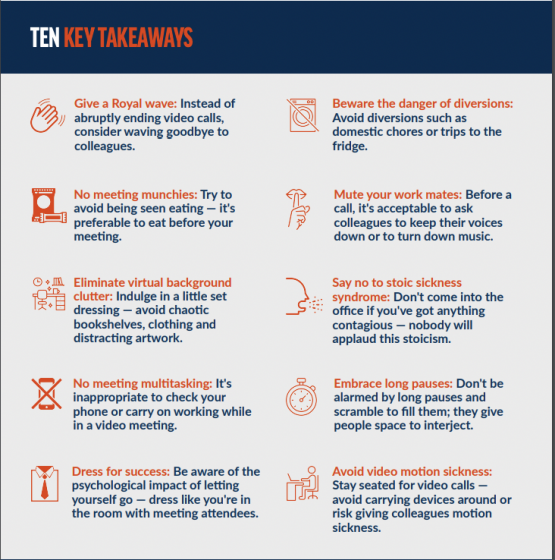Samir Sayed, Managing Director for ASEAN, Korea, Emerging Markets & Pakistan for Hybrid Work Solutions at HP says “The shift to hybrid work was so abrupt, we’ve not really considered how our behaviour should change to accommodate this new way of working. Should we be amending our behaviour to make hybrid work and hybrid meetings feel more normal? Thinking about how to make hybrid meetings feel more natural will create an equal meeting experience, whether people are in the room or dialling-in from home, which can come down to employers providing staff with the right technology and training.”
“With people increasingly splitting their time between the office and home, how we conduct ourselves at work has changed drastically,” says Liz Wyse, Etiquette Advisor at Debrett’s. “It is clear that hybrid working offers many benefits, including greater flexibility and a better work-life balance. However, that’s not an excuse to let etiquette slip, and standards should stay the same regardless of where you’re working from. What’s the dress code when working from home? How do you eliminate distractions and present a professional façade online? This guide seeks to answer these questions so that both staff and employers can get the most out of a hybrid working arrangement.”
The comprehensive guide offers insight into everything from how to behave on video calls and how to dress yourself and your background, to body language tips and the importance of eliminating distractions. Key takeaways include:
- Give a Royal wave: Ending a video call can sometimes feel a bit awkward. To make calls feel more friendly and inclusive, you can soften the abrupt finality of pressing ‘End call’ by giving colleagues a wave goodbye.
- Avoid video motion sickness: Stay in a fixed position during video calls. Carrying your device while you answer the door or wander around the office during video calls risks giving your colleagues a bad dose of motion sickness.
- No meeting munchies: You should try to avoid eating – you don’t want people to focus on the contents of your lunch rather than what you’re saying. It’s preferable to eat before you join a meeting.
- Beware the danger of diversions: Your home is full of diversions. Be it domestic chores, the garden or visits to the fridge – it’s all too easy to wander around doing jobs or making snacks, which ultimately distracts you from your job and impacts your productivity.
- Eliminate virtual background clutter: Indulge in a little set-dressing before your call. Evaluate your video background. Try to eliminate chaotic bookshelves, discarded clothing, empty take-away containers and distracting artwork. You want your colleagues to focus on you, not your background.
- Say no to stoic sickness syndrome: Do not struggle into the office if you have got a cough or cold or anything contagious. Nobody will applaud your stoicism.
- No meeting multitasking: It’s inappropriate to multitask during meetings – for example looking at your phone. It is also very bad form to carry on working while on a call; everybody will realise your mind is elsewhere and hear the incriminating clatter of your keyboard.
- Mute your work mates: Noise in the office can be distracting when joining calls. It’s quite acceptable to politely ask your colleagues to keep their voices down and to turn down their radio or music.
- Dress for success: People will choose to wear more relaxed, comfortable clothing when working from home, but it’s important to be aware of the psychological impact of truly letting yourself go. Aim to dress as if you are in the room with other meeting attendees.
- Embrace long pauses: Don’t be alarmed by long pauses during meetings and scramble to fill them with chatter; they are an invaluable way of giving people space to interject or expound.
Looking ahead, instead of giving everyone the same equipment, organisations should understand how people like to work and collaborate, and the spaces they use – including their home office setup. This can be used to tailor the equipment provided, allowing employees to look their best, be heard, feel included and avoid distraction, irrespective of where they’re working from.
To learn more about the new etiquette for hybrid work, please click here. An infographic can also be found here.

The Broll who always got your back online!






